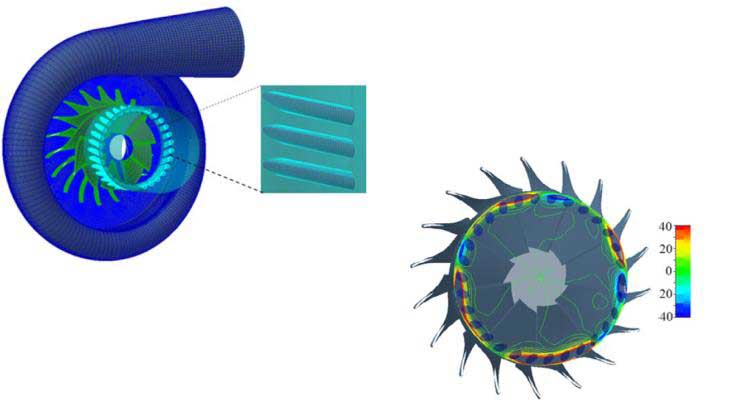Background
Current turbocharger designs suffer from flow range limitations that lead to inefficient turbocharger compressor and turbine choices. Enhanced range, coupled with high boost pressure, is essential to achieve low fuel consumption in internal combustion engines. This new innovative compressor inlet invention increases substantially compressor flow range with the use of an inlet duct that pre-swirls the inlet flow of the turbocharger compressor.
Flow range limitations often lead to multi-stage compressor systems that make the installation bulky and complex. This concept creates the opportunity to reduce cost by using a single stage turbocharger or possibly by eliminating the need for a variable geometry turbocharger.
Technology Overview
Simulation indicates a 26% decrease in surge mass flow rate, whilst limiting the decrease in chocked mass flow to a small negative change of 2.8%. Consequently the turbocharger transient response could be improved by up to 18%.

Absolute flow angle distribution near inlet of the impeller with IDT at low flow conditions (near surge)-positive swirled effect, which benefits the impeller stability by reducing the incidence angle.
It is considered that this technology will be applicable across the whole range of turbo and super charger applications from automotive, industrial, through to large static power and marine applications.
Benefits
- Novel blockage geometry upstream of the compressor, located close to the blade tips to improve aerodynamic stability and delay the inception of surge.
- Inlet Duct Treatment (IDT) offers a 26% improvement to map width in steady conditions, and a 33%improvement in pulsating flow condition compared to a commercial Casting Treatment (CT).
- Manufacturing costs saving. IDT is a simple geometry placed upstream of the flow.
Applications
The IDT concept can be applied to all turbochargers and to all centrifugal compressors where near-surge operation is significant.
Intellectual Property Information
This IDT concept is patented in the US (US10240612), China (CN105339673) and EP (EP2994647) validated in the UK, Germany and France.




